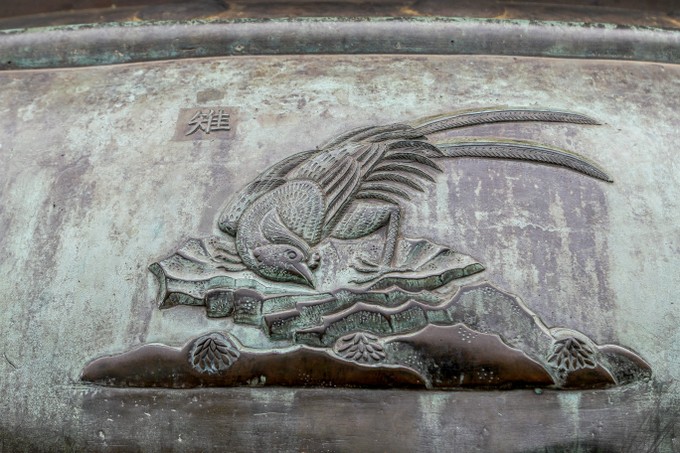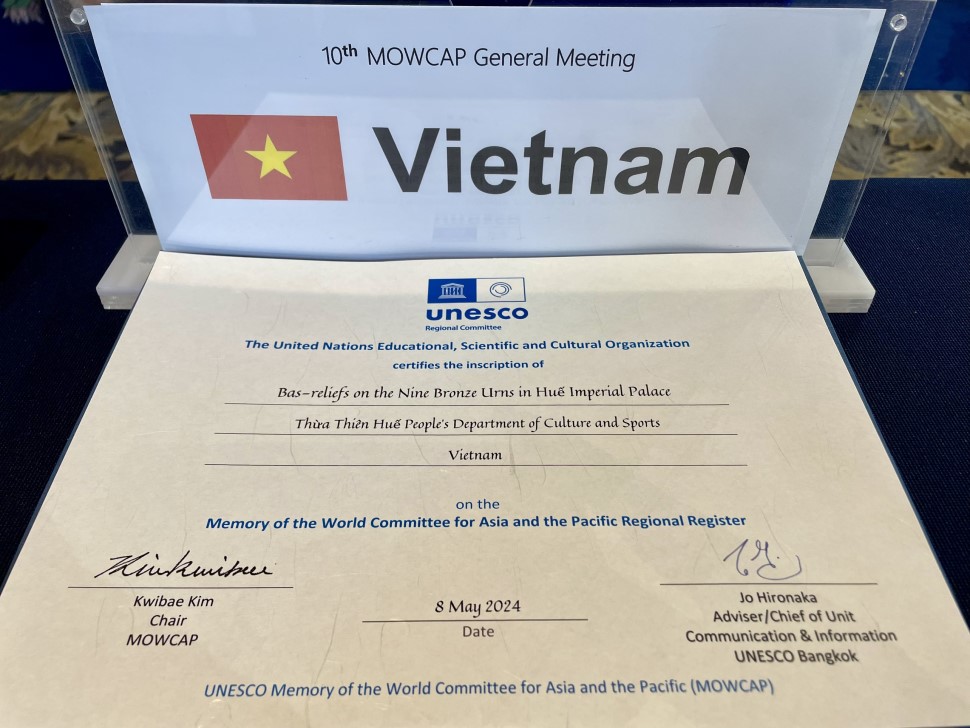
Bas-reliefs on nine dynastic urns in the Hue Imperial Palace have been inscribed in the Memory of the World Register.
The announcement was made in the Mongolian capital on Wednesday during the 10th plenary meeting of the Memory of the World Committee for Asia and the Pacific. The urns were unanimously approved by all 23 member countries.
Weathering 200 years of war and time, the nine urns are still intact, never having been repaired, not even a small detail. This makes the set unique and irreplaceable. It was recognized as a National Treasure in 2012.
The nine dynastic urns were cast for two years, from 1835 to 1837, during the reign of King Minh Mang (1820-1840), and placed in front of The Mieu Yard in Hue Imperial City, each representing a dynastic period of the Nguyen Dynasty.
| Nine dynastic urns in the Hue Imperial Palace in the central province of Thua Thien-Hue. Photo: VNA |
The number of urns is 9, a sacred number in Eastern belief, symbolizing heaven, absolute perfection and the authority and strength of the ruler.
All the urns, cast by the best craftsmen of the time on the orders of King Minh Mang, embody the royal power and showcase the Kingdom of Vietnam's rich flora and fauna. They represent the aspiration to build a strong and stable country for future generations.
The urns were cast in 1835 and it took artisans a year to carve the details of 153 patterns and nine typographies.
In addition to their historical and artistic value, the 152 patterns are an authentic and rare resource for researchers, as they also have cultural, educational, geographical, medical, fengshui and calligraphic significance.
| A bird embossed on the urn. Photo courtesy of the Ministry of Culture, Sports and Tourism |
From 1802 to 1945, the Nguyen dynasty, with Gia Long as the founding emperor and Bao Dai as the last, ruled the kingdom of Dai Nam (the former name of Vietnam) with 13 kings.
The urns feature rivers, mountains, seas and islands. In particular, among the nine urns, the three cast under the reign of Minh Mang bear the sea, signifying his kingdom's sovereignty over the land and also the seas.
According to experts, the patterns of the nine urns in the Hue Imperial Citadel form a unique panoramic work of art. The way of creation and the decorative reliefs imply the ideology of an era, people's thoughts and ideas about the country, the universe and nature.
| The delegates listen to the presentation of the dossier on the nine urns. Photo courtesy of the Ministry of Culture, Sports and Tourism |
The Nguyen dynasty urns join nine other Vietnamese heritage elements on UNESCO's Memory of the World Register in the Asia-Pacific region.
Le Thi Thu Hien, Chairwoman of the Vietnam National Committee for Memory of the World (MOW), Director of the Department of Cultural Heritage, Ministry of Culture, Sports and Tourism, said it was a rewarding result for Vietnam's efforts to protect and promote the value of cultural heritage in general and documentary heritage in particular.
According to Hien, the new UNESCO-listed heritage will be a new resource that will help promote the city's potential, attract tourism and international cooperation, and thus contribute to the city's development.
| Certificate of the UNESCO Memory of the World Committee for Asia and the Pacific. Photo courtesy of the Department of Cultural Heritage |
"So far, Vietnam has 10 documentary heritage elements registered by UNESCO, which is the practical basis for the Ministry of Culture, Sports and Tourism to develop management, protection and promotion policies. Documentary heritage will be regulated by a new chapter in the Law on Cultural Heritage (amended) to be passed by the National Assembly by the end of 2024," Hien said.
Le Thi Hong Van, Secretary General of the Vietnam National Commission for UNESCO, said this was a joy not only for Thua Thien-Hue Province, but also an honor and pride for all Vietnamese people.
According to Van, this represents the recognition and trust that regional and international countries have for Vietnam in preserving and promoting documentary heritage values.
"The fact that Thua Thien-Hue has another UNESCO World Heritage element will help the province strengthen links, share experiences and improve skills in preserving and accessing documentary heritage in the region," Van said.



.jpg)


